Media Censorship in USA and Australia: A Comparative Examination
VerifiedAdded on 2021/04/19
|7
|1615
|90
Essay
AI Summary
This essay provides a comparative analysis of media censorship in the USA and Australia. It begins by defining censorship and then examines film and television censorship, noting that both countries have relatively similar approaches, although Australia sometimes bans films more frequently. The essay then explores comic book censorship, highlighting the role of the Comics Code Authority in the USA and the absence of a similar body in Australia. Finally, it contrasts book censorship in the two countries, pointing out that the USA has stricter and more extensive book censorship practices compared to Australia, which focuses on publications unsuitable for minors or offensive to the public. The essay concludes that while both countries are less rigid than others, there are notable differences in the organization and strictness of censorship rules, particularly concerning books.
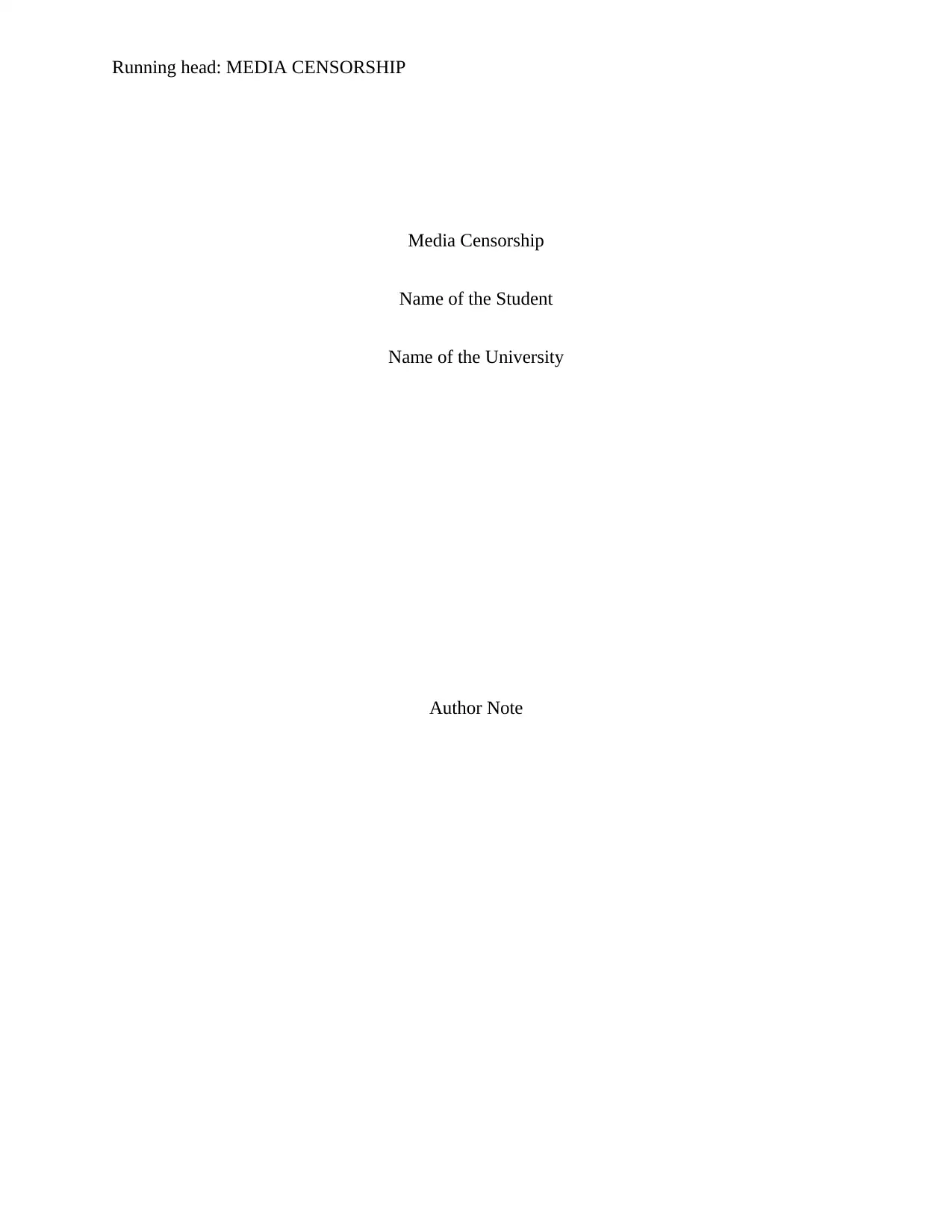
Running head: MEDIA CENSORSHIP
Media Censorship
Name of the Student
Name of the University
Author Note
Media Censorship
Name of the Student
Name of the University
Author Note
Paraphrase This Document
Need a fresh take? Get an instant paraphrase of this document with our AI Paraphraser
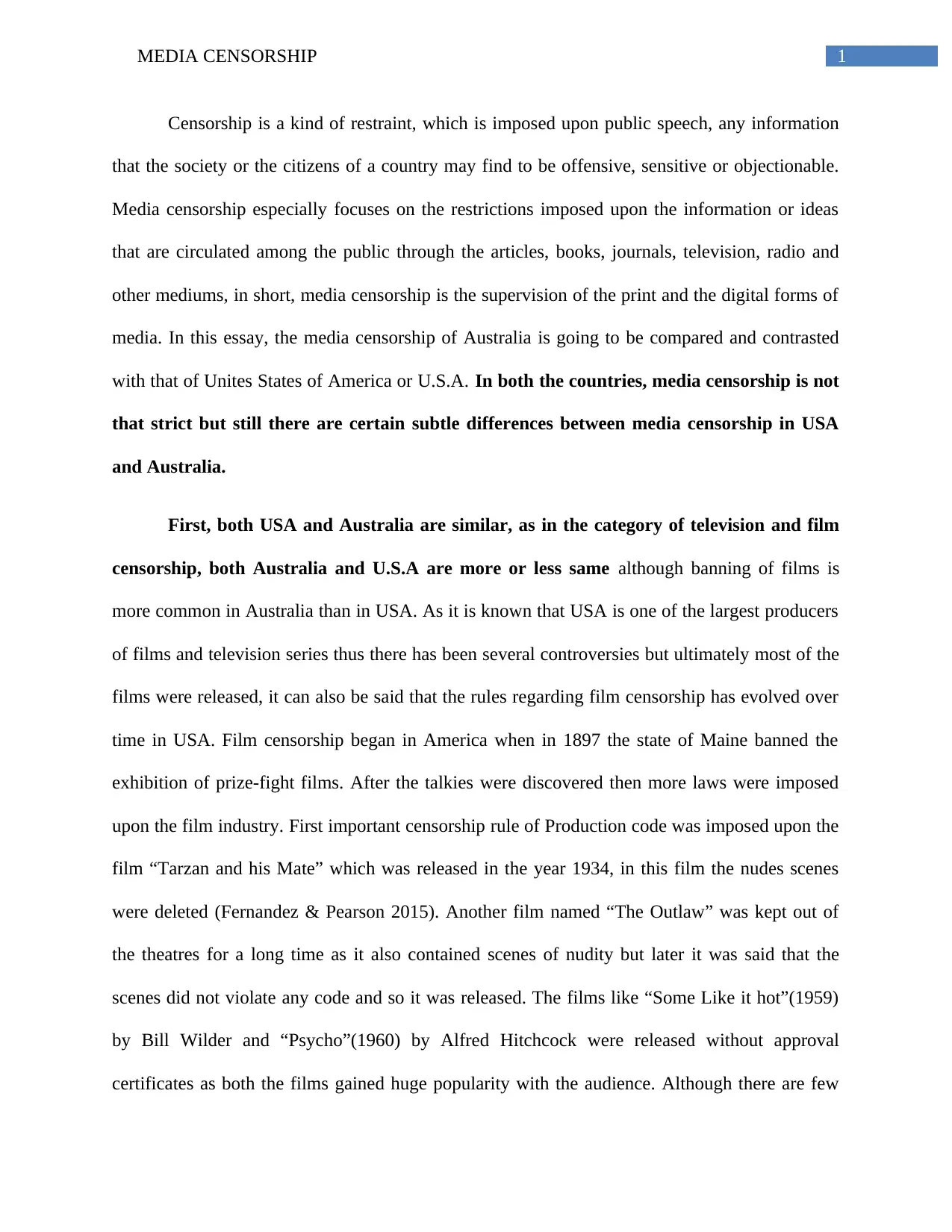
1MEDIA CENSORSHIP
Censorship is a kind of restraint, which is imposed upon public speech, any information
that the society or the citizens of a country may find to be offensive, sensitive or objectionable.
Media censorship especially focuses on the restrictions imposed upon the information or ideas
that are circulated among the public through the articles, books, journals, television, radio and
other mediums, in short, media censorship is the supervision of the print and the digital forms of
media. In this essay, the media censorship of Australia is going to be compared and contrasted
with that of Unites States of America or U.S.A. In both the countries, media censorship is not
that strict but still there are certain subtle differences between media censorship in USA
and Australia.
First, both USA and Australia are similar, as in the category of television and film
censorship, both Australia and U.S.A are more or less same although banning of films is
more common in Australia than in USA. As it is known that USA is one of the largest producers
of films and television series thus there has been several controversies but ultimately most of the
films were released, it can also be said that the rules regarding film censorship has evolved over
time in USA. Film censorship began in America when in 1897 the state of Maine banned the
exhibition of prize-fight films. After the talkies were discovered then more laws were imposed
upon the film industry. First important censorship rule of Production code was imposed upon the
film “Tarzan and his Mate” which was released in the year 1934, in this film the nudes scenes
were deleted (Fernandez & Pearson 2015). Another film named “The Outlaw” was kept out of
the theatres for a long time as it also contained scenes of nudity but later it was said that the
scenes did not violate any code and so it was released. The films like “Some Like it hot”(1959)
by Bill Wilder and “Psycho”(1960) by Alfred Hitchcock were released without approval
certificates as both the films gained huge popularity with the audience. Although there are few
Censorship is a kind of restraint, which is imposed upon public speech, any information
that the society or the citizens of a country may find to be offensive, sensitive or objectionable.
Media censorship especially focuses on the restrictions imposed upon the information or ideas
that are circulated among the public through the articles, books, journals, television, radio and
other mediums, in short, media censorship is the supervision of the print and the digital forms of
media. In this essay, the media censorship of Australia is going to be compared and contrasted
with that of Unites States of America or U.S.A. In both the countries, media censorship is not
that strict but still there are certain subtle differences between media censorship in USA
and Australia.
First, both USA and Australia are similar, as in the category of television and film
censorship, both Australia and U.S.A are more or less same although banning of films is
more common in Australia than in USA. As it is known that USA is one of the largest producers
of films and television series thus there has been several controversies but ultimately most of the
films were released, it can also be said that the rules regarding film censorship has evolved over
time in USA. Film censorship began in America when in 1897 the state of Maine banned the
exhibition of prize-fight films. After the talkies were discovered then more laws were imposed
upon the film industry. First important censorship rule of Production code was imposed upon the
film “Tarzan and his Mate” which was released in the year 1934, in this film the nudes scenes
were deleted (Fernandez & Pearson 2015). Another film named “The Outlaw” was kept out of
the theatres for a long time as it also contained scenes of nudity but later it was said that the
scenes did not violate any code and so it was released. The films like “Some Like it hot”(1959)
by Bill Wilder and “Psycho”(1960) by Alfred Hitchcock were released without approval
certificates as both the films gained huge popularity with the audience. Although there are few
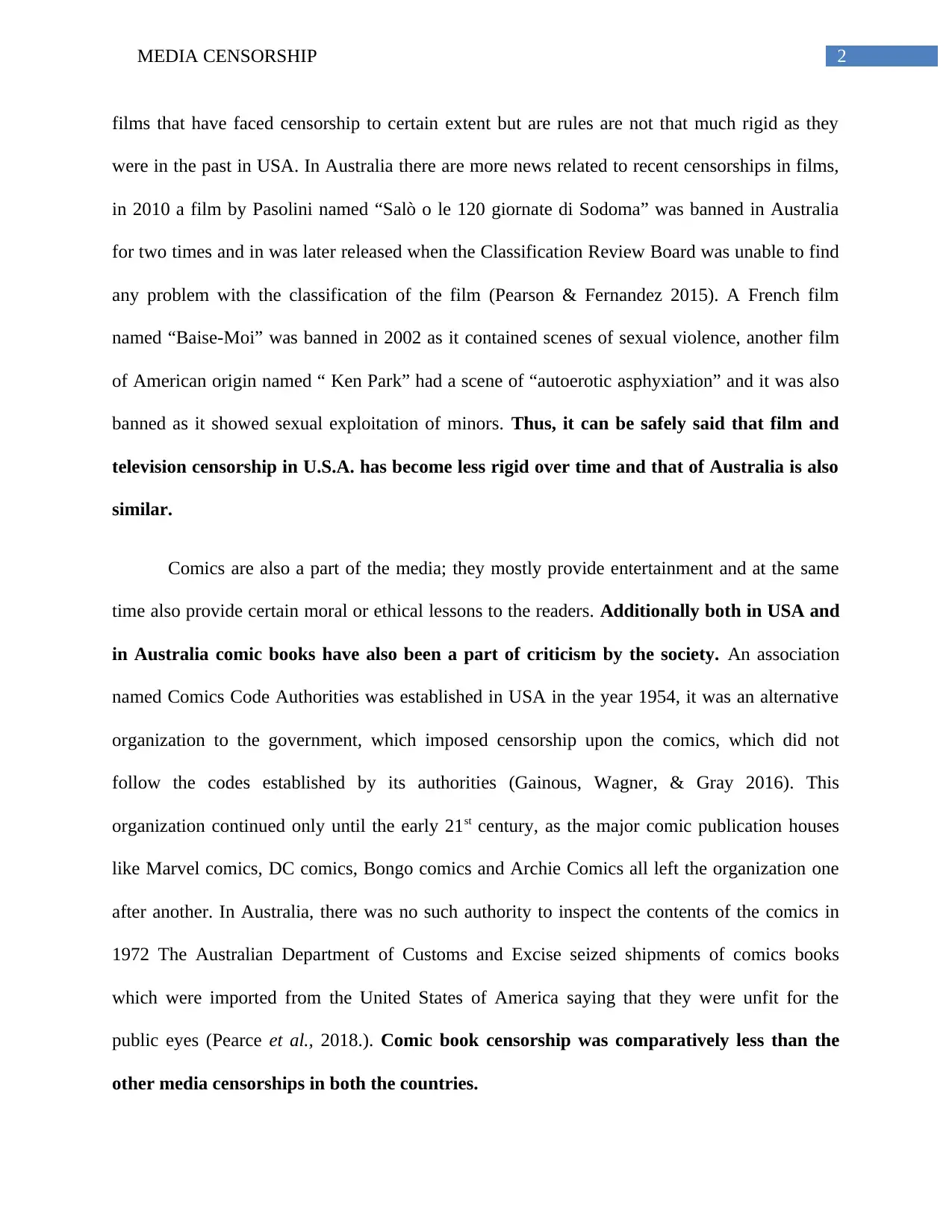
2MEDIA CENSORSHIP
films that have faced censorship to certain extent but are rules are not that much rigid as they
were in the past in USA. In Australia there are more news related to recent censorships in films,
in 2010 a film by Pasolini named “Salò o le 120 giornate di Sodoma” was banned in Australia
for two times and in was later released when the Classification Review Board was unable to find
any problem with the classification of the film (Pearson & Fernandez 2015). A French film
named “Baise-Moi” was banned in 2002 as it contained scenes of sexual violence, another film
of American origin named “ Ken Park” had a scene of “autoerotic asphyxiation” and it was also
banned as it showed sexual exploitation of minors. Thus, it can be safely said that film and
television censorship in U.S.A. has become less rigid over time and that of Australia is also
similar.
Comics are also a part of the media; they mostly provide entertainment and at the same
time also provide certain moral or ethical lessons to the readers. Additionally both in USA and
in Australia comic books have also been a part of criticism by the society. An association
named Comics Code Authorities was established in USA in the year 1954, it was an alternative
organization to the government, which imposed censorship upon the comics, which did not
follow the codes established by its authorities (Gainous, Wagner, & Gray 2016). This
organization continued only until the early 21st century, as the major comic publication houses
like Marvel comics, DC comics, Bongo comics and Archie Comics all left the organization one
after another. In Australia, there was no such authority to inspect the contents of the comics in
1972 The Australian Department of Customs and Excise seized shipments of comics books
which were imported from the United States of America saying that they were unfit for the
public eyes (Pearce et al., 2018.). Comic book censorship was comparatively less than the
other media censorships in both the countries.
films that have faced censorship to certain extent but are rules are not that much rigid as they
were in the past in USA. In Australia there are more news related to recent censorships in films,
in 2010 a film by Pasolini named “Salò o le 120 giornate di Sodoma” was banned in Australia
for two times and in was later released when the Classification Review Board was unable to find
any problem with the classification of the film (Pearson & Fernandez 2015). A French film
named “Baise-Moi” was banned in 2002 as it contained scenes of sexual violence, another film
of American origin named “ Ken Park” had a scene of “autoerotic asphyxiation” and it was also
banned as it showed sexual exploitation of minors. Thus, it can be safely said that film and
television censorship in U.S.A. has become less rigid over time and that of Australia is also
similar.
Comics are also a part of the media; they mostly provide entertainment and at the same
time also provide certain moral or ethical lessons to the readers. Additionally both in USA and
in Australia comic books have also been a part of criticism by the society. An association
named Comics Code Authorities was established in USA in the year 1954, it was an alternative
organization to the government, which imposed censorship upon the comics, which did not
follow the codes established by its authorities (Gainous, Wagner, & Gray 2016). This
organization continued only until the early 21st century, as the major comic publication houses
like Marvel comics, DC comics, Bongo comics and Archie Comics all left the organization one
after another. In Australia, there was no such authority to inspect the contents of the comics in
1972 The Australian Department of Customs and Excise seized shipments of comics books
which were imported from the United States of America saying that they were unfit for the
public eyes (Pearce et al., 2018.). Comic book censorship was comparatively less than the
other media censorships in both the countries.
⊘ This is a preview!⊘
Do you want full access?
Subscribe today to unlock all pages.

Trusted by 1+ million students worldwide
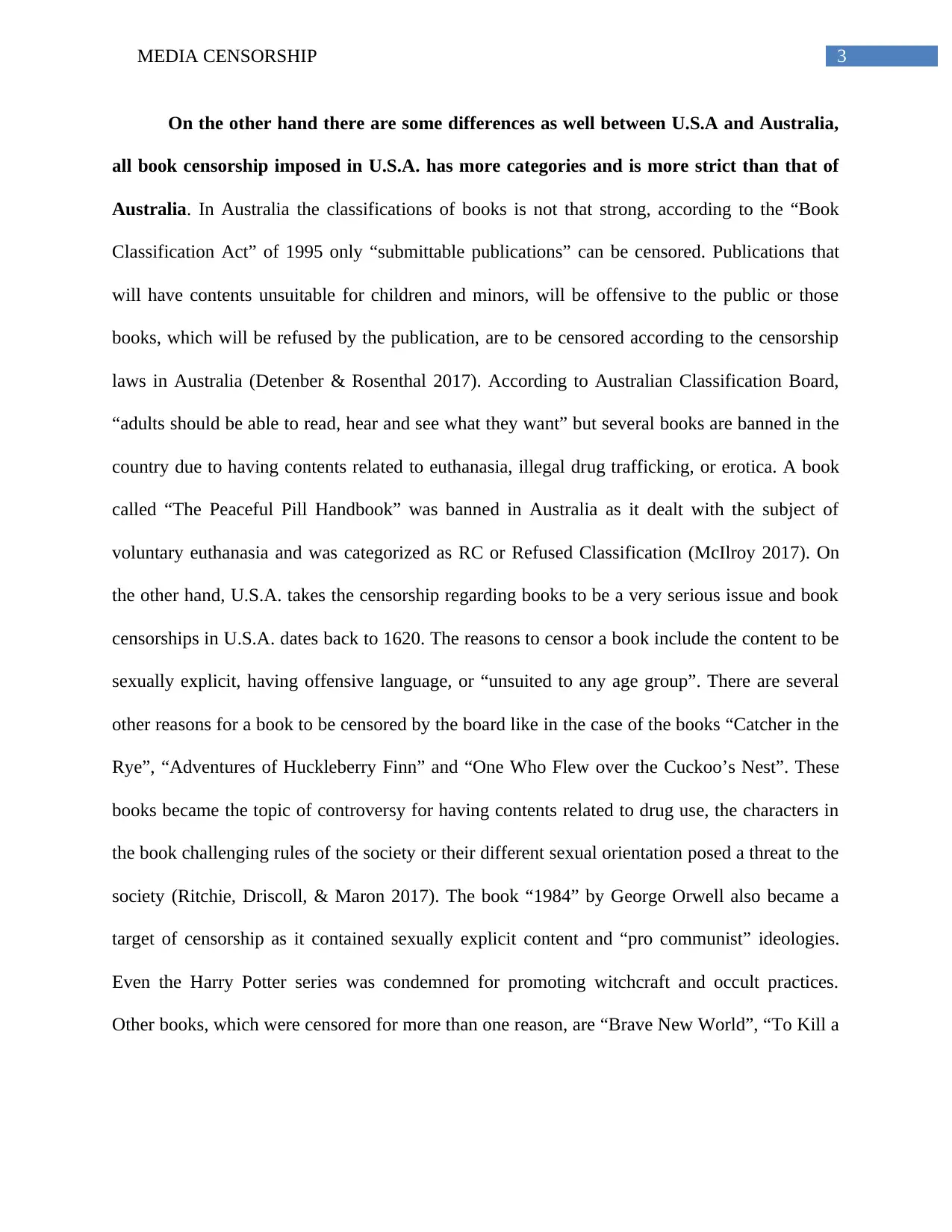
3MEDIA CENSORSHIP
On the other hand there are some differences as well between U.S.A and Australia,
all book censorship imposed in U.S.A. has more categories and is more strict than that of
Australia. In Australia the classifications of books is not that strong, according to the “Book
Classification Act” of 1995 only “submittable publications” can be censored. Publications that
will have contents unsuitable for children and minors, will be offensive to the public or those
books, which will be refused by the publication, are to be censored according to the censorship
laws in Australia (Detenber & Rosenthal 2017). According to Australian Classification Board,
“adults should be able to read, hear and see what they want” but several books are banned in the
country due to having contents related to euthanasia, illegal drug trafficking, or erotica. A book
called “The Peaceful Pill Handbook” was banned in Australia as it dealt with the subject of
voluntary euthanasia and was categorized as RC or Refused Classification (McIlroy 2017). On
the other hand, U.S.A. takes the censorship regarding books to be a very serious issue and book
censorships in U.S.A. dates back to 1620. The reasons to censor a book include the content to be
sexually explicit, having offensive language, or “unsuited to any age group”. There are several
other reasons for a book to be censored by the board like in the case of the books “Catcher in the
Rye”, “Adventures of Huckleberry Finn” and “One Who Flew over the Cuckoo’s Nest”. These
books became the topic of controversy for having contents related to drug use, the characters in
the book challenging rules of the society or their different sexual orientation posed a threat to the
society (Ritchie, Driscoll, & Maron 2017). The book “1984” by George Orwell also became a
target of censorship as it contained sexually explicit content and “pro communist” ideologies.
Even the Harry Potter series was condemned for promoting witchcraft and occult practices.
Other books, which were censored for more than one reason, are “Brave New World”, “To Kill a
On the other hand there are some differences as well between U.S.A and Australia,
all book censorship imposed in U.S.A. has more categories and is more strict than that of
Australia. In Australia the classifications of books is not that strong, according to the “Book
Classification Act” of 1995 only “submittable publications” can be censored. Publications that
will have contents unsuitable for children and minors, will be offensive to the public or those
books, which will be refused by the publication, are to be censored according to the censorship
laws in Australia (Detenber & Rosenthal 2017). According to Australian Classification Board,
“adults should be able to read, hear and see what they want” but several books are banned in the
country due to having contents related to euthanasia, illegal drug trafficking, or erotica. A book
called “The Peaceful Pill Handbook” was banned in Australia as it dealt with the subject of
voluntary euthanasia and was categorized as RC or Refused Classification (McIlroy 2017). On
the other hand, U.S.A. takes the censorship regarding books to be a very serious issue and book
censorships in U.S.A. dates back to 1620. The reasons to censor a book include the content to be
sexually explicit, having offensive language, or “unsuited to any age group”. There are several
other reasons for a book to be censored by the board like in the case of the books “Catcher in the
Rye”, “Adventures of Huckleberry Finn” and “One Who Flew over the Cuckoo’s Nest”. These
books became the topic of controversy for having contents related to drug use, the characters in
the book challenging rules of the society or their different sexual orientation posed a threat to the
society (Ritchie, Driscoll, & Maron 2017). The book “1984” by George Orwell also became a
target of censorship as it contained sexually explicit content and “pro communist” ideologies.
Even the Harry Potter series was condemned for promoting witchcraft and occult practices.
Other books, which were censored for more than one reason, are “Brave New World”, “To Kill a
Paraphrase This Document
Need a fresh take? Get an instant paraphrase of this document with our AI Paraphraser
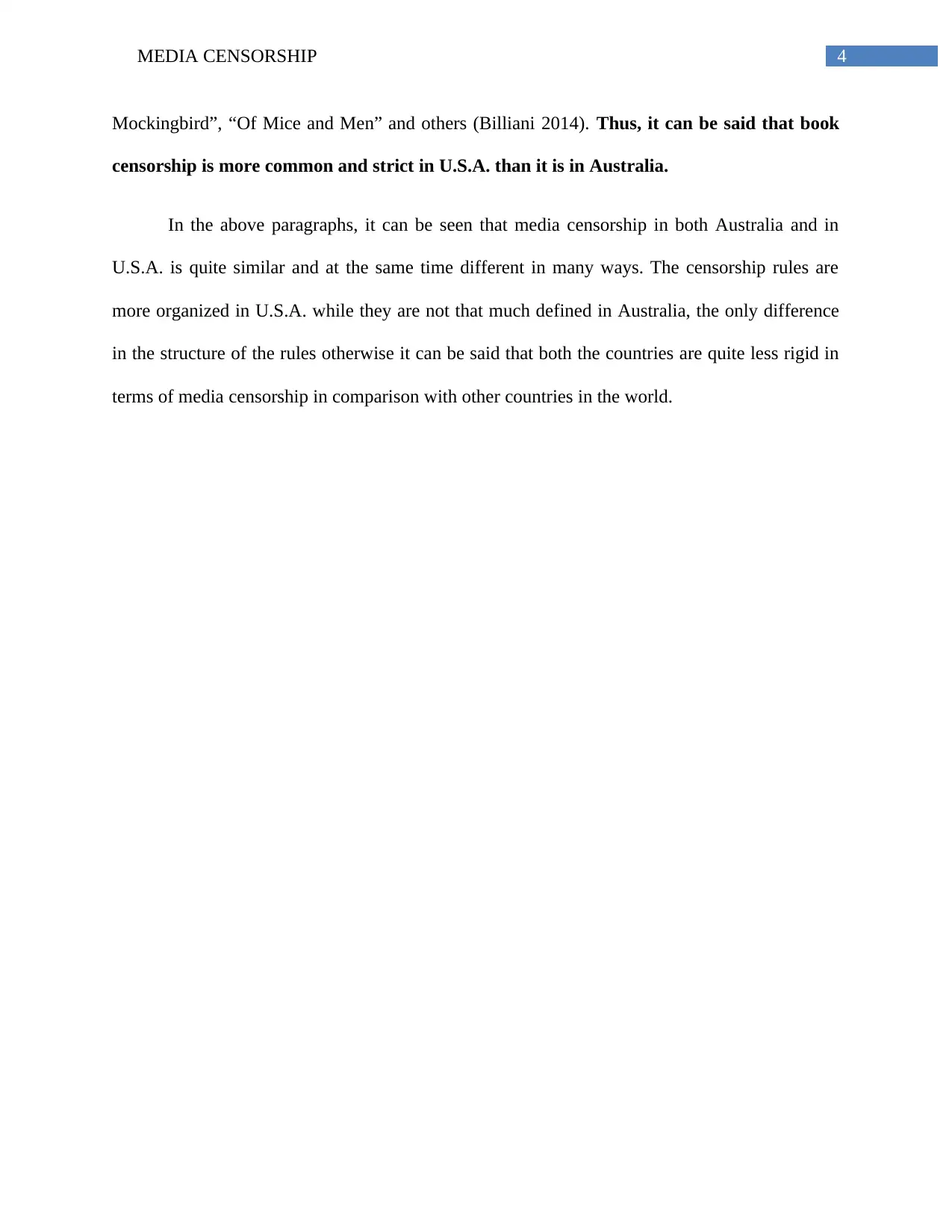
4MEDIA CENSORSHIP
Mockingbird”, “Of Mice and Men” and others (Billiani 2014). Thus, it can be said that book
censorship is more common and strict in U.S.A. than it is in Australia.
In the above paragraphs, it can be seen that media censorship in both Australia and in
U.S.A. is quite similar and at the same time different in many ways. The censorship rules are
more organized in U.S.A. while they are not that much defined in Australia, the only difference
in the structure of the rules otherwise it can be said that both the countries are quite less rigid in
terms of media censorship in comparison with other countries in the world.
Mockingbird”, “Of Mice and Men” and others (Billiani 2014). Thus, it can be said that book
censorship is more common and strict in U.S.A. than it is in Australia.
In the above paragraphs, it can be seen that media censorship in both Australia and in
U.S.A. is quite similar and at the same time different in many ways. The censorship rules are
more organized in U.S.A. while they are not that much defined in Australia, the only difference
in the structure of the rules otherwise it can be said that both the countries are quite less rigid in
terms of media censorship in comparison with other countries in the world.
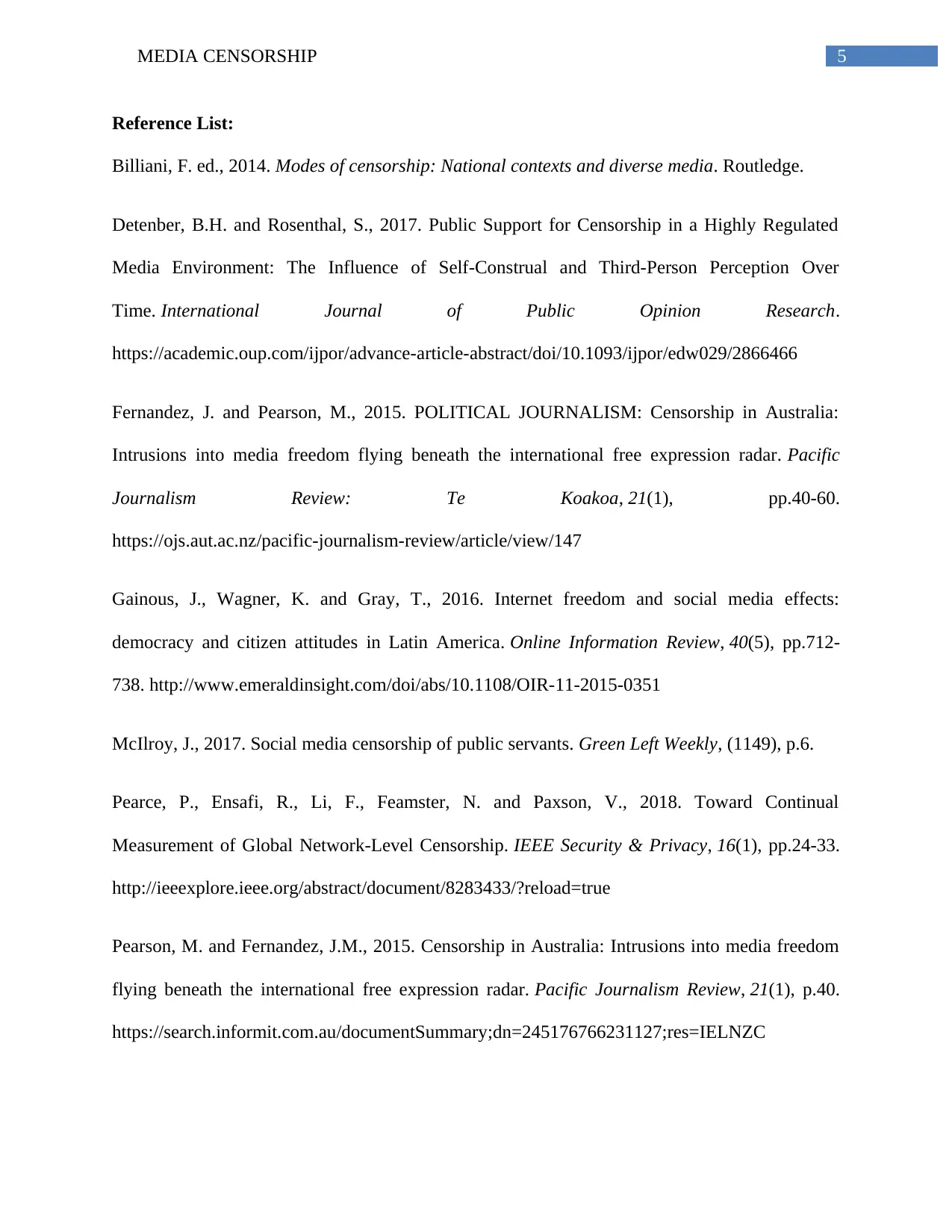
5MEDIA CENSORSHIP
Reference List:
Billiani, F. ed., 2014. Modes of censorship: National contexts and diverse media. Routledge.
Detenber, B.H. and Rosenthal, S., 2017. Public Support for Censorship in a Highly Regulated
Media Environment: The Influence of Self-Construal and Third-Person Perception Over
Time. International Journal of Public Opinion Research.
https://academic.oup.com/ijpor/advance-article-abstract/doi/10.1093/ijpor/edw029/2866466
Fernandez, J. and Pearson, M., 2015. POLITICAL JOURNALISM: Censorship in Australia:
Intrusions into media freedom flying beneath the international free expression radar. Pacific
Journalism Review: Te Koakoa, 21(1), pp.40-60.
https://ojs.aut.ac.nz/pacific-journalism-review/article/view/147
Gainous, J., Wagner, K. and Gray, T., 2016. Internet freedom and social media effects:
democracy and citizen attitudes in Latin America. Online Information Review, 40(5), pp.712-
738. http://www.emeraldinsight.com/doi/abs/10.1108/OIR-11-2015-0351
McIlroy, J., 2017. Social media censorship of public servants. Green Left Weekly, (1149), p.6.
Pearce, P., Ensafi, R., Li, F., Feamster, N. and Paxson, V., 2018. Toward Continual
Measurement of Global Network-Level Censorship. IEEE Security & Privacy, 16(1), pp.24-33.
http://ieeexplore.ieee.org/abstract/document/8283433/?reload=true
Pearson, M. and Fernandez, J.M., 2015. Censorship in Australia: Intrusions into media freedom
flying beneath the international free expression radar. Pacific Journalism Review, 21(1), p.40.
https://search.informit.com.au/documentSummary;dn=245176766231127;res=IELNZC
Reference List:
Billiani, F. ed., 2014. Modes of censorship: National contexts and diverse media. Routledge.
Detenber, B.H. and Rosenthal, S., 2017. Public Support for Censorship in a Highly Regulated
Media Environment: The Influence of Self-Construal and Third-Person Perception Over
Time. International Journal of Public Opinion Research.
https://academic.oup.com/ijpor/advance-article-abstract/doi/10.1093/ijpor/edw029/2866466
Fernandez, J. and Pearson, M., 2015. POLITICAL JOURNALISM: Censorship in Australia:
Intrusions into media freedom flying beneath the international free expression radar. Pacific
Journalism Review: Te Koakoa, 21(1), pp.40-60.
https://ojs.aut.ac.nz/pacific-journalism-review/article/view/147
Gainous, J., Wagner, K. and Gray, T., 2016. Internet freedom and social media effects:
democracy and citizen attitudes in Latin America. Online Information Review, 40(5), pp.712-
738. http://www.emeraldinsight.com/doi/abs/10.1108/OIR-11-2015-0351
McIlroy, J., 2017. Social media censorship of public servants. Green Left Weekly, (1149), p.6.
Pearce, P., Ensafi, R., Li, F., Feamster, N. and Paxson, V., 2018. Toward Continual
Measurement of Global Network-Level Censorship. IEEE Security & Privacy, 16(1), pp.24-33.
http://ieeexplore.ieee.org/abstract/document/8283433/?reload=true
Pearson, M. and Fernandez, J.M., 2015. Censorship in Australia: Intrusions into media freedom
flying beneath the international free expression radar. Pacific Journalism Review, 21(1), p.40.
https://search.informit.com.au/documentSummary;dn=245176766231127;res=IELNZC
⊘ This is a preview!⊘
Do you want full access?
Subscribe today to unlock all pages.

Trusted by 1+ million students worldwide
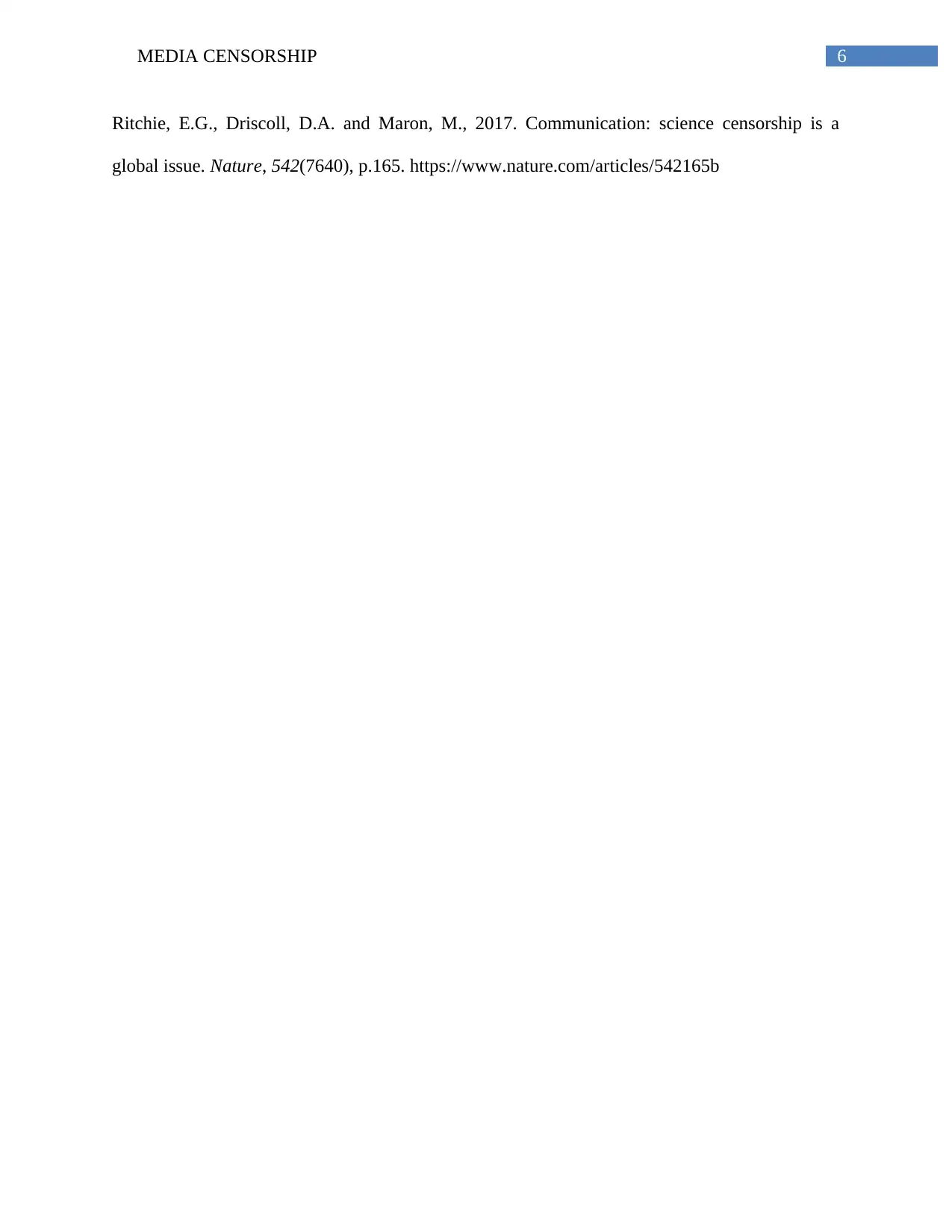
6MEDIA CENSORSHIP
Ritchie, E.G., Driscoll, D.A. and Maron, M., 2017. Communication: science censorship is a
global issue. Nature, 542(7640), p.165. https://www.nature.com/articles/542165b
Ritchie, E.G., Driscoll, D.A. and Maron, M., 2017. Communication: science censorship is a
global issue. Nature, 542(7640), p.165. https://www.nature.com/articles/542165b
1 out of 7
Your All-in-One AI-Powered Toolkit for Academic Success.
+13062052269
info@desklib.com
Available 24*7 on WhatsApp / Email
![[object Object]](/_next/static/media/star-bottom.7253800d.svg)
Unlock your academic potential
Copyright © 2020–2025 A2Z Services. All Rights Reserved. Developed and managed by ZUCOL.
